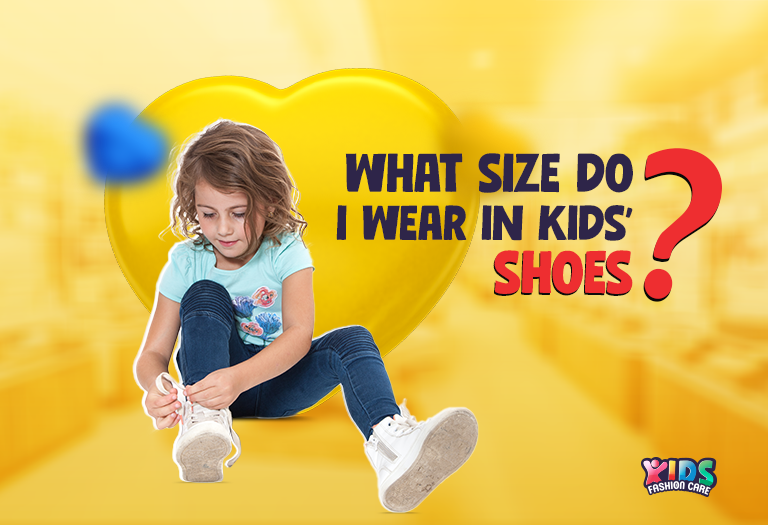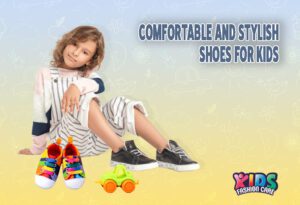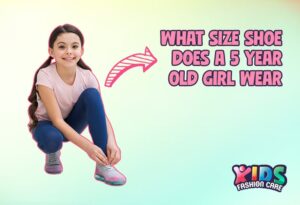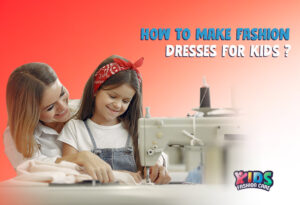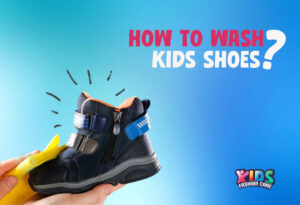First, measure your child’s feet with a feet ruler or by drawing their foot on a piece of paper. When you get the longest size measurement for your kids shoes, that’s what you need to count to find the right pair of shoes for your child based on their age.
Introductions
Have you bought the wrong size shoe for your child? Or, the pair of shoes you bought at the start of the month is very close fitting; who knows whether it will fit next month anymore!
Things like this happen because kids’ feet are unpredictable. But the question is, how do you know which size will fit your child? Or how do you find the right-sized show for your child to wear?
I will answer these questions for you in this article. Let’s get started.
Table of Contents
What Size Do I Wear in Little Kids Shoes?
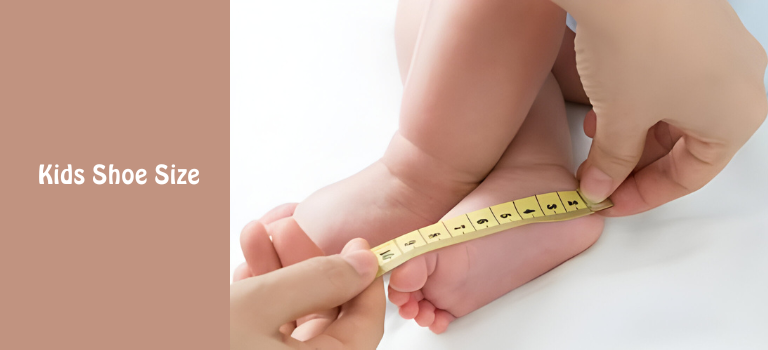
To let your kids wear the right size shoe, it’s good if you can understand the shoe size conversion chart for children. Many sellers will have a sizing guideline published on their website. If they don’t you can ask for one.
For better understanding, I will be assisting you in shoe size charts, based on age. I have included here one.
Age-Appropriate Shoe Sizing Considerations
Finding the right shoe depends wholly on measuring the right size as per the child’s age. How do you know the kids shoe sizes as per their age?
Don’t worry. Check the chart listed below for your convenience, where I have noted down the approximate foot size in inches as per their age.
| Category | Children’s Age | Foot in Inch |
| Newborn | 0 to 2 months of age | 3.5 inches |
| Infant | Upto 12 months of age | 4 Inches and above |
| Toddler | 1 to 3 years of age | 5 to 6 inches and above |
| Preschoolers | 4 to 5 years of age | 7 Inches and above |
| Children | 6 to 12 years of age | 7 to 9 inches and above |
Kids Shoe Sizes Conversion Charts & Fit Guide
Infants and toddlers don’t have any different shoe sizes based on their gender. Here is a chart for shoes for kids based on their age.
| Categories | Age Range | US/AU Size | UK Size | EU Size |
| Newborn | 0 to 2 months of age | 16 | ||
| Infant | Upto 12 months of age | 02C to 05C | 01C to 04C | Upto 19 |
| Toddler | 1 to 3 years of age | 3C to 9C | 04C to 08C | 20 to 25 |
| Preschoolers | 4 to 5 years of age | 10C to 12.5C | 9C to 10C | 26 to 28 |
Children | 6 to 7 years | 13.5C to 1Y | 12C to 13C | 31 to 33 |
| 8 to 9 years | 2Y to 3Y | 1Y to 3Y | 35 to 36 | |
| 10 to 12 years | 4Y to 6Y | 4Y to 7Y | 36 to 37 |
Note: In the US, baby (newborn to 4 years old) shoe sizes are counted from 0C to 10C.
How to Measure Kids’ Feet?
If you are looking to measure your child’s feet, there are different ways to do it. Here is how I take the measurement of my children’s feet.
A. Basic Measurement
The basic way of measuring a child’s foot can be done in the following ways.
- With a Piece of Paper
Step 1: Take a piece of paper. Let your child step on it.
Step 2: With a pen, draw a dot on the heel and another dot on the longest toe (mostly not the biggest toe).
Step 3: Lift your child’s foot, and connect these 2 dots into one single line with one ruler. Also, measure foot width.
- With a Thread
Step 1: Let your child sit on the floor. Then put a tool beneath one of his/her feet.
Step 2: Take a thread, and measure it from his/her heel to the longest toe. Then, cut it accordingly.
Step 3: Measure the tread to get the measurement.
These are the ways you get the size of your child’s feet.
B. Trace the Foot
Step 1: Take a piece of A4 paper. Ask your child to stand on it.
Step 2: Then draw the whole foot as per the foot size.
Step 3: After the tracing has been done, take the longest vertical measurement.
C. Measure with a Foot Ruler
Thanks to ecommerce, I got to order a foot ruler which made my measuring process easier.
Step 1: Take a foot ruler, and place it on the flat floor.
Step 2: Ask your child to put one foot on it. Note down the size.
Step 3: Then do the same process for the other foot.
Step 4: Now compare both feet measurements and take the larger one. That’s the appropriate foot size for your children.
How to Confirm If Your Child’s Shoe Fits Properly?
There are a few signs that help you understand that a pair of shoes has adjusted perfectly on a child’s shoes. Those are:
- The heel will feel firm on the shoe.
- The toes will be extendable and have 1 to 2 inches of space inside the shoe.
- The laced part will feel not too tight.
Overall, the shoe grip will feel comfortably loose, and relaxed, not too tight.
How to Know if Children’s Shoes are Big or Small?
If you have purchased new shoes but back in your mind you feel that this isn’t right, but can’t verify, you probably are right. You need to look for signs to understand if your kids are yet to speak of their discomfort. What are those signs?
Signs of shoes are small
- They might complain that their feet hurt.
- Shoes don’t have space at the toe area when they wear.
- They need to twist their toes while wearing.
- They are less likely to perform work that requires wearing shoes.
Signs of shoes are big
- They can’t work normally, dragging their feet.
- While walking they lift their heels off.
- They often trip over on their ankle while walking.
- They get blisters whenever they put on the shoes.
- Kids feet are outgrowing kids shoes. The same shoes doesn’t fit anymore.
Tips for Online Shoe Shopping
Shopping new shoes online is convenient and fast. Even so, finding the right shoe size for children is another level of struggle. Even though you have the right measurements, mistakes may occur. What you can do is follow these mentioned tips.
Team up with Your Child
This is a unique combination, believe me. I often team up with my little kids to buy not only their essentials but also mine. These moments are beyond explanation. Also, you can watch and learn what your kids like or not and decide what to buy.
Note the Materials
Consider noting down little kid shoe materials. Like adult shoes, toddler shoes are also made of different materials, and some children are prone to be allergic. So you might want to have a look if the material is breathable and the shoes are not too heavy.
Check the Sizing Chart
Most shoe brands have their size charts based on children’s age. So, before you order from a specific seller, do a check of their sizing chart. As feet size based on country varies. If the seller sends the product from the manufacturer’s country warehouse, where children’s feet are generally large or small compared to their age, you might end up getting the wrong shoe.
Scrutinize the Features
Are you looking for any specific type of features for your child’s kid? I remember when my firstborn was a couple of months old, I always ordered cotton-made baby shoes, not have any lace or zipper, only elasticity. My concert was not to bother the baby with extra decorations. Check for the features you are looking for, for example, adjustable straps, laces, etc.
Consider the Factors for Feet Measurement
- Time: Refrain from taking foot size in the morning. That’s when feet are smaller in size. Take the feet measurement in the afternoon or evening. This is the time when the foot’s position stays at its largest, due to walking.
- Odd size: If your child’s feet are in between sizes, then go for the large size. Also, take measurements of both feet and buy shoes as per the larger numbered one.
- Activities: Before measuring, let your child do some physical movements like jumping, walking, and dancing. So that you get the right foot size.
Consider the Necessary
How frequently will your baby wear this pair of shoes? Are you looking for them to wear regularly or for any particular occasions or outdoor activities? Depending on the purpose and necessity, you might need to adjust the choice of shoes.
Order One Size Large
Children grow up so fast, that sometimes it is difficult to track time. I bought a large size of jeans for my elder son last month, and it’s already fitting for him. So, while making the purchase, order one size larger than their actual size.
Check Seller’s Review
Don’t just randomly order from any seller, just because it has some fancy baby shoes. Read the reviews, and what other parents have to say about it. Also, try to have these answers.
- Does it offer quality and durable items?
- Are their items comfortable for children to wear?
- Is the customer service responsive to hear you out?
- What is their return and exchange policy if the shoes don’t fit?
Many people will tell you to rely on renowned sellers. Products from branded sellers are pricey. So, my recommendation is to check for yourself. There is a wide range of sellers with quality items, looking to thrive in their business. It won’t hurt to give them a shot.
Frequently Asked Questions (FAQs)
Question: How do I know my kid’s shoe size?
Answer: Online stores have sizing charts based on the kid’s age. You can follow that to know the kids shoe sizes. Or, by using a foot ruler or tracing your child’s feet on paper, you can know the foot measurement to buy the right shoe size.
Question: How Often Should You Measure Your Child’s Feet?
Answer: Measure your child’s feet every 4 to 6 months. But the wise way to measure is according to their age.
Here is how.
Infants, 0 months to 12 months: Take measurement on each 1 month (4 weeks).
Toddlers, 1 to 3 years: Measure their feet every 2 months (8 weeks).
Pre-schoolers, 4-5 years: Note their foot measurements 4-6 months.
Children, 6 to 12 years: Children’s feet need to be measured every 6 to 8 months.
Question: What size is needed to wear for big kids shoes?
Answer: If your child has faster growth than his/her peers, s/he needs kid’s shoe size a bit larger. So, measure both of his/her feet and consider the larger measurement to buy shoes.
Conclusion
That’s the end of my article on little kids shoe size conversion, hopefully, your confusion regarding child’s shoe size has been cleared out. Knowing the right size of shoe is important because a pair of shoes will help support your kids no matter what type of activities they are engaged in. So, make sure you are focusing on their foot size measurement accurately.
Keep an eye on my articles to learn more updates on kid fashion. Catch you up in my next article.

